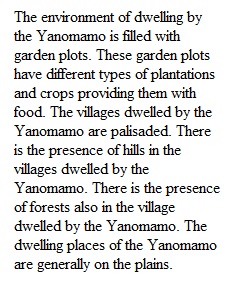


Q ZOOM Anthropology 102 Cultural Anthropology D. Earle Essay II A major focus of Unit II in this course is the food quest (subsistence), and how it affects the organization of social groups- families, households, kin groups, and communities, and helps determine a group's total culture or way of life. The food quest is itself very much related to the environment that a human group lives in. For your essay, you will want to carefully review Chapter 2, "Cultural Ecology", in Chagnon's book on the Yanomamo that deals with the cultural ecology of the Yanomamo - how the Yanomamo satisfy their food needs and meet their other material needs by successfully exploiting and adapting to their environment. Other chapters or sections of the book are also relevant here. You should describe, in your paper, several principal features of Yanomamo cultural ecology. (1) First, major features of the environment the Yanomamo live in. (2) Second, the techniques of how the Yanomamo meet their food needs, and how these dovetail with the environment. This food acquisition involves three MAJOR DIFFERENT types of food getting systems discussed in lecture! (3) Third, the most important food getting technology of the Yanomamo may affect their system of settlement- i.e. how they set up or move their village settlements. What does Chagnon say about how meeting food needs may force villages to change location? (4) Are there other NON-FOOD-PRODUCTION RELATED factors that also may cause the Yanomamo to move the locations of their shabono villages- what are these? Be sure to discuss these other factors in detail! In summary, in dealing with Points 3) and 4), be sure to discuss circumstances that may cause what Chagnon calls a village "micro-move", and also discuss conditions or factors that can lead to what he calls a "macro-move". What is the difference between these moves and what are the differences between the CAUSES of these different moves? How often do villages actually do "micro-moves" and how often do the do "macromoves"? Finally, WHY are "macro-moves" so DIFFICULT, and what strategies do the Yanomamo have to deal with these difficulties and survive a "macro-move"?FURTHER INSTRUCTIONS:The essay should be at least 4 pages double-spaced and should cover the points discussed above. References will not be necessary. The essay is worth 25 points.
View Related Questions